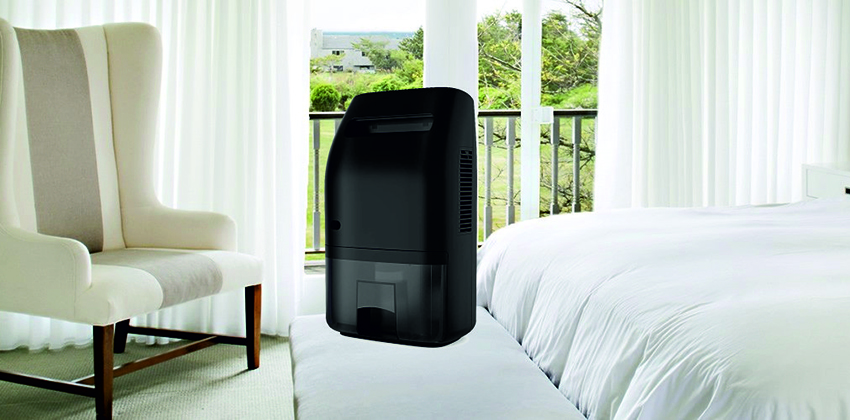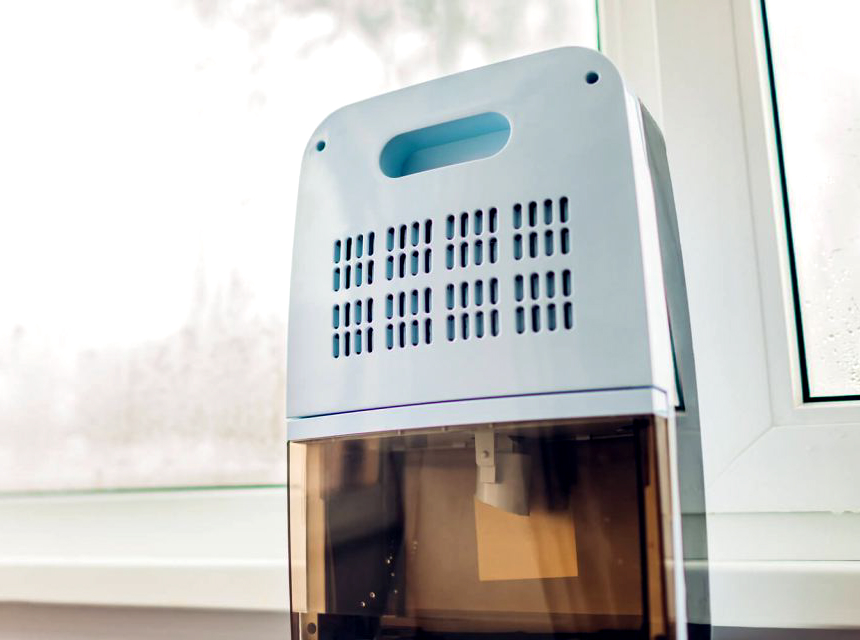

If you the air in your home is too humid it can cause a lot of discomfort. Extreme sweatiness, uncontrollable hair and irritability are just some of the side effects of humidity. As for your belongings, high humidity can quickly warp wooden valuables, not to mention create the perfect environment for dangerous mold to grow. The solution to high humidity is a device that will remove moisture from the air. But that then leads to the debate, dehumidifier vs fan. To help you out, we’ve put together this article that highlights the pros and cons of each appliance.
A dehumidifier works by circulating air through a machine. Moisture in the air is captured and air without moisture is expelled back out into the room. The water is collected into a container that will need to be emptied periodically, usually about ever one to three days.
Different dehumidifiers will work with different sizes of rooms. You can find small machines that are meant for a bedroom or large-sized ones that can work in a basement. There are even dome dehumidifiers that can be connected to your air conditioner unit and will work on the whole house.
A dehumidifier is built to remove moisture from the air. It is exactly what you need if your home is too humid.
Because a dehumidifier removes moisture from the air, that water is then stored in a container. The water needs to be emptied on a regular basis, otherwise the dehumidifier will automatically stop working. This can create an extra chore for you, which can become a bit frustrating.
Fans don’t actually target humidity levels: instead it’s a nice side effect of using a fan. Fans work by rapidly increasing the circulation of the air inside a room. If placed near a window, a fan can move cooler air into a room, thus lessening the overall humidity inside.
Ceiling fans are less effective as they aren’t able to move air from the outside to the inside. However, they can help in the overall air temperature and are suitable for semi-humid environments.
Most fans are portable so you can move them around your home as needed. They are also inexpensive and can be used for dual purposes: the decrease humidity and create a pleasant, cool sensation.
If you want to use a fan to dehumidify your house, it won’t work if there is a lot of moisture in the air. A fan also won’t work if it’s more humid outside than inside as it will just bring more moisture into your home.
To really breakdown the benefits of both a dehumidifier and a fan, let’s look at how they compare in the following categories.
There are different types of fans and dehumidifiers that require different levels of installation. In their most basic sense, both machines can be stand-alone products that don’t require any installation at all.
If you want to dehumidify your basement or even your whole house, then you will need to install a more powerful dehumidifier. In this case you will also need access to a drainage pipe for the excess water that it will trap.
Some fans can be installed into a window and this can take a bit of maneuvering. The same goes with ceiling fans which will also need electrician expertise.
Basically, if you want to target a small room, you can find a simple fan or dehumidifier that doesn’t requite installation. For a larger room, apartment, or basement, than you will need a more powerful fan or dehumidifier and this will definitely require installation.
When it comes to energy consumption, it really boils down to the cost of running a fan vs a dehumidifier. Unfortunately, this is really hard to compare. Dehumidifiers are usually more powerful and give off more heat, making them use more energy than fans. However, there are many types of fans and more powerful ones can use a lot of energy, too. It’s best to look at specific models in each category to really understand the energy consumption and therefore cost.
Depending on their size, both dehumidifiers and fans can be portable. Larger dehumidifiers are obviously less portable and ceiling fans are definitely not portable.
Some dehumidifiers can be hooked up to a drainage pipe, which greatly limits their portability if you want to take advantage of this option.
Both a dehumidifier and a fan will need to be monitored for any maintenance issues. A dehumidifier may require more repairs in its lifetime, thanks to the more complex machinery it has. A dehumidifier works with water and if an issue arises with the water tank, a lot of mechanical issues can arise. A fan is a bit more straightforward but can still have its own issues.
It’s recommended to perform a quick inspection every month on your device. The sooner you can diagnose a problem, the greater the probability it won’t turn into a major disaster. Also pay attention to the warranty. If the end of your warranty is approaching, do a thorough examination of your product, just in case. If there is an issue, contact customer service right away for help or even a replacement.
Dehumidifiers actively remove moisture from the air. Fans move air around. If you live in a very humid climate, have bad air circulation in your home, or have a lot of valuables you want to protect, it’s best to go with a dehumidifier. It might be a bit more expensive but it will work much better than a fan.
There is a lot to consider when deciding which product will work best to dehumidify your home. Whether the humidity exists because of your daily routine or the outside climate can greatly determine which solution is best. In the debate of dehumidifier vs fan, a dehumidifier wins if you have extreme, persistent humidity while a fan will be just fine for lower, infrequent humidity.





